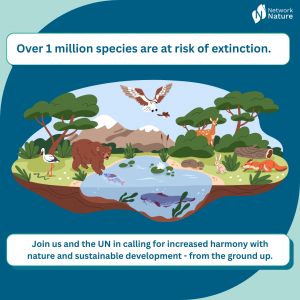
Biodiversity is fundamental to human and environmental well-being, yet we are losing it at an unprecedented rate: between 1970 and 2020, the average size of monitored wildlife populations decreased by 73% and over 1 million species are at risk of extinction. While everyone has seen an image of a polar bear on a shrinking iceberg, the ground beneath our feet has received far less attention.
This World Biodiversity Day, NetworkNature joins the international call for harmony with nature and sustainable development by shining a spotlight on soil. 59% of all biodiversity on Earth is found in the soil. From microbes to mammals, the ground beneath our feet is abuzz with life. Consider the sand (or short-haired) bumblebee (Bombus subterraneus), endangered and rare, an important pollinator that nests - you guessed it - underground. Nail Fungus (Poronia punctata) , an important decomposer with the less than glamorous job of breaking down livestock dung, has also joined the ranks of endangered and threatened soil species.
Within our lifetimes, soils are effectively a non-renewable resource. Soils not only house almost half of all life on Earth but they also perform essential services - services we would do well to avoid having to live without. Soil is responsible for:
- storing 80% of terrestrial carbon
- acting as a sink for air pollutants
- serving as the substrate for as much as 86% of all plants
- buffering climate extremes
- limiting flooding
- growing 95% of the food we eat.
The value of soil is inarguable, yet 60% of EU soils are classified as unhealthy, and the UN estimates that we are losing as much as a soccerfield’s worth of topsoil worldwide per second.
Cities are noticing, and taking action to reverse this trend. Take for instance Nantes Metropole, home to 24 municipalities and 250 km of rivers and streams - and a common societal challenge: providing sufficient affordable housing for its growing population, while avoiding net land take. Nantes is ahead of the curve, and has recognised that the common denominator in these competing land uses is soil. The solution? Work with local stakeholders and authorities to systematically unseal soil (remove impermeable surfaces), and avoid installing impermeable surfaces in new construction.
Initiatives like those in Nantes will play a key role in facing and combatting the wide range of challenges Europe’s soils face (see more in the NetworkNature library for more soil related case studies). They cannot however do it alone. To meet the challenges of intensive agriculture, urbanisation, climate change, land degradation, and soil sealing, we need to normalise the inclusion of soil in nature conservation and planning processes across departments and governance levels.
NetworkNature is helping cities advocate for (inter)national coordinated responses, and innovate local solutions by providing tools and case studies that address soil conservation. What’s more, the news is not all bad: soil health and biodiversity are increasingly centered in EU policies and initiatives, such as the EU Mission “A Soil Deal for Europe,” the EU Soil Strategy for 2030, and the pending Soil Monitoring and Resilience Law. Additionally, the EU Biodiversity Strategy and the Nature Restoration Regulation also make provisions for the protection of the flora and fauna beneath our feet.
Particularly ambitious is the EU Mission “A Soil Deal for Europe,” which strives to facilitate the transition to more healthy soils by 2030 via the following ambitious objectives:
- Reduce land degradation
- Conserve and increase soil organic carbon stocks
- No net soil sealing and increase the reuse of urban soils
- Reduce soil pesticide pollution and enhance restoration
- Prevent erosion
- Reduce the EU global footprint on soils
- Improve soil structure
- Increase soil literacy in Member States
- Nature conservation of soil biodiversity
Cities and regions are not without tools to fulfill the promise of Mission Soil. Urban Nature Plans, a planning framework co-developed by ICLEI Europe and Eurocities with dozens of European cities for the European Commission—help mainstream nature as a key priority across city planning, and provide ample room to include soil as a core consideration. The ambitious Berlin Urban Nature Pact also supports signatories in setting and achieving soil targets.
Also promising is the soon to be adopted EU Soil Monitoring Law. This directive is expected to set a legal framework for soil protection and data collection across Member States, requiring Member States to adopt sustainable soil management principles. The horizon project SOLO is helping cities realise the law, by investigating knowledge gaps impeding the consideration of soil and biodiversity in planning and governance.
While many initiatives are top down, there are also opportunities for cities, regions, and planners to voice their own concerns and priorities, contributing to the creation of new tools and practices that center and further soil health and biodiversity. Amongst them is the EU project SPADES, which is working with 17 pilots, amongst Nantes, to promote the integration of soil into the planning practice. The project is currently collecting insights from planning professionals and municipalities to better understand current gaps, needs, and opportunities. The results of the survey (contributions due end of June 2025) will inform the contents and structure of the SPADES Navigator, a planning tool that will support cities and regions in aligning planning processes with soil functions.
The work in Nantes is only one example of many, but provides a clear illustration of how a large municipality can take the steps to make soil conservation a priority. Cities or regions wanting to learn from Nantes and other soil health frontrunners can join the SoilTribes Community of Practice to engage in peer learning, networking, and access to a grants scheme totalling more than € 1.5 million.
"SoilTribes and its community of practice combine science, technology, policy, and the arts to foster soil literacy and raise ecological awareness. The project will fund and support the development of 30 creative communication campaigns and public engagement initiatives based on compelling “back-to-Earth” narratives. Our hope is that these will generate and multiply impact, by inspiring a deeper connection to the land, transforming our perceptions, feelings and actions towards our soils.”
-Stephania Xydia, ICLEI Europe Expert, Built Environment, Culture and Heritage
Soil is the most biodiverse habitat on Earth and the time to protect it is now. Join Nantes and NetworkNature in the call to center soil when conserving biodiversity.
